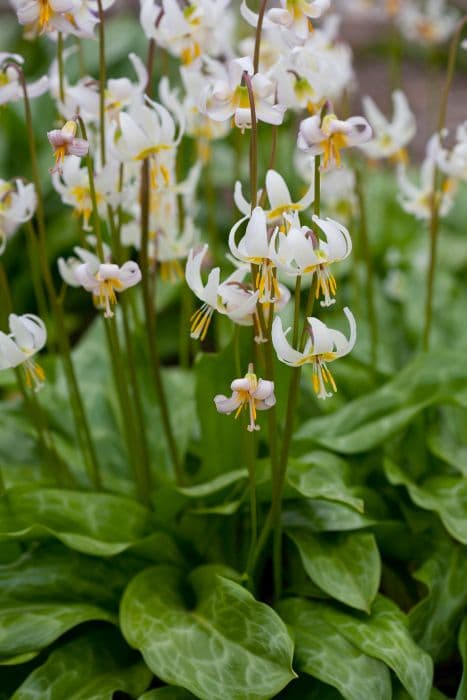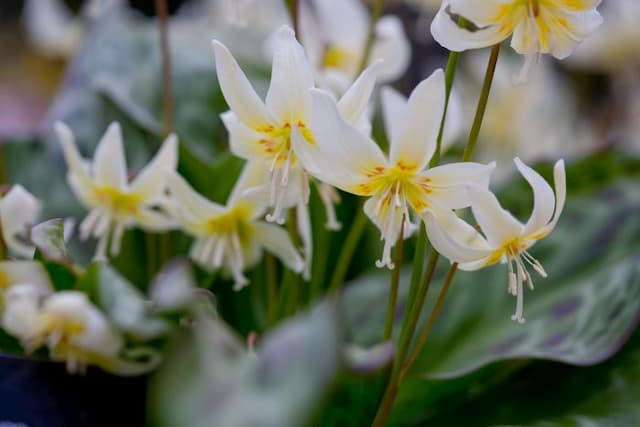California Fawn Lily Erythronium multiscapideum

ABOUT
Erythronium multiscapideum, commonly known as the Sierra Fawn Lily, is a perennial plant noted for its attractive springtime flowers and lush foliage. The plant typically sports a small number of flowers crowning slender stems that arise from a bulb beneath the soil. Each blossom is shaped like a nodding bell with six petal-like segments that are often bright yellow and sometimes display a gradient of color leading to a lighter base. The inner surface of the petals frequently exhibits a distinctive reddish-brown spot near the base, adding to its ornamental appeal. The leaves of the Sierra Fawn Lily are equally eye-catching. Growing at the base, they emerge in pairs, with each leaf displaying an elongated, lance-shaped profile. The foliage is glossy and has a lush green color that may be mottled with maroon or brownish patterns. This plant is typically found in the wild, gracing meadows and woodland floors where it adds bursts of color with its showy blooms. The appeal of the Sierra Fawn Lily makes it a desirable addition to gardens designed to emulate natural settings or those aiming to include native plants. Despite its delicate appearance, this wildflower has adapted to survive in specific environments and, when conditions are right, can form impressive colonies that are a spectacle to behold each spring.
About this plant
 Names
NamesFamily
Liliaceae
Synonyms
Adder's-Tongue, Fawn Lily, Klamath Fawn Lily, Many-Stemmed Fawn Lily
Common names
Erythronium multiscapideum.
 Toxicity
ToxicityTo humans
The plant commonly known as White Fawnlily (Erythronium multiscapideum) is not typically known for being poisonous to humans. However, as with many wild plants, it is always possible for certain individuals to experience adverse reactions due to allergies or sensitivities. In general, it's wise to avoid ingesting wild plants unless they are known to be safe and are correctly identified.
To pets
White Fawnlily (Erythronium multiscapideum) does not have a well-documented record of being toxic to pets. Nevertheless, caution should be exercised, and pets should not be allowed to ingest plants of which the toxicity is not fully known. It's best to prevent pets from eating wild plants to avoid any potential for poisoning or gastrointestinal upset.
 Characteristics
CharacteristicsLife cycle
Perennials
Foliage type
Deciduous
Color of leaves
Green
Flower color
White
Height
1 foot (30 cm)
Spread
1 foot (30 cm)
Plant type
Bulb
Hardiness zones
7
Native area
North America
Benefits
 General Benefits
General Benefits- Aesthetic Appeal: Erythronium multiscapideum, commonly known as Adder's Tongue, offers a unique and delicate beauty to gardens with its slender stems and attractive pale yellow or white flowers.
- Pollinator Support: The nectar and pollen of Adder's Tongue flowers attract various pollinators, including bees and butterflies, which are essential for a healthy ecosystem.
- Naturalization: Adder's Tongue is capable of naturalizing in an appropriate woodland setting, spreading gradually to create charming drifts of color in the spring.
- Ground Cover: With its low-growing habit, Adder's Tongue can serve as a lovely ground cover in shaded areas, filling in spaces between larger plants and helping to suppress weeds.
- Seasonal Interest: This plant blooms in early spring, providing an early source of interest and color in the garden after winter dormancy.
- Deer Resistance: Adder's Tongue is regarded as deer-resistant, making it an appropriate choice for areas where deer browsing is a problem for gardeners.
- Diverse Habitat: By planting Adder's Tongue, gardeners can contribute to creating diverse habitats that support a range of wildlife species.
- Erosion Control: The foliage of Adder's Tongue can help to stabilize soil in sloped or otherwise erosion-prone areas.
 Medical Properties
Medical PropertiesThis plant is not used for medical purposes.
 Air-purifying Qualities
Air-purifying QualitiesThis plant is not specifically known for air purifying qualities.
 Other Uses
Other Uses- Erythronium multiscapideum, commonly known as the White Fawn Lily, can be used in landscape design for naturalizing woodland gardens, taking advantage of its delicate and attractive flowers to provide a native aesthetic.
- In specialty gardens such as alpine or rock gardens, the White Fawn Lily can offer early spring interest with its unique foliage and blossoms that stand out among rockery plants.
- The plant has been used by educators and naturalists for educational purposes to demonstrate how native plants coexist with their environment and the importance of preserving them.
- White Fawn Lily bulbs could potentially be used in culinary arts as part of foraged cuisine, although care should be taken to ensure the bulbs are not from protected populations.
- The plant serves as an indicator species in its native habitat, signaling the health of a given ecosystem, particularly those that are under conservation management.
- Native to California, the White Fawn Lily is sometimes utilized in restoration projects to help re-establish native flora and reduce the presence of invasive species.
- Beekeepers may value the presence of the White Fawn Lily in the vicinity for its early bloom, providing forage for bees in the spring.
- Photographers and artists may seek out the White Fawn Lily for its aesthetic value, capturing its beauty in art and photography which in turn can promote appreciation for native plant species.
- Enthusiasts of sustainable gardening practices might use the White Fawn Lily as a teaching example of drought-resistant plants that require minimal watering once established.
- The ephemeral nature of the White Fawn Lily, with its foliage dying back after flowering, can be used to illustrate the lifecycle of perennials in nature programs or in botanical gardens.
Interesting Facts
 Feng Shui
Feng ShuiErythronium multiscapideum, commonly known as California fawn lily, is not used in Feng Shui practice.
 Zodiac Sign Compitability
Zodiac Sign CompitabilityCalifornia fawn lily is not used in astrology practice.
 Plant Symbolism
Plant Symbolism- Adder's Tongue: The most common name for Erythronium multiscapideum is Adder's Tongue, and this plant symbolizes healing and restoration. The name itself suggests a forked tongue, resembling that of a snake, which has long been associated in various cultures with medicinal properties and transformation.
- Purity: With its delicate and pure white flowers, Adder's Tongue is often associated with purity and innocence, akin to the symbolic meanings attributed to many other white flowering plants.
- Resilience: Growing in the wild, often in challenging conditions, Adder's Tongue embodies resilience and the ability to thrive in adversity, symbolizing the human capacity to endure and flourish despite obstacles.
- Springtime: As a plant that emerges in the spring, Adder's Tongue is symbolic of renewal, new beginnings, and the cycle of life, reflecting the rebirth that comes with this season.
 Water
WaterTo water the Adder's Tongue properly, ensure the soil is kept evenly moist during its growth period. Typically, in the spring while the plant is actively growing and flowering, Adder's Tongue may need watering approximately once a week. Depending on temperature and soil conditions, this should equate to around 1-2 gallons per week for an established cluster of plants. After flowering and as the foliage begins to die back late in spring, reduce watering gradually until the plant goes dormant in summer, at which point watering can cease until the next growing season begins.
 Light
LightThe Adder's Tongue thrives best in dappled sunlight conditions, which mimic its natural woodland habitat. It is ideal to place it in a spot where it can receive filtered sunlight through the canopy of taller trees or a lattice. Avoid exposing the Adder's Tongue to the harsh afternoon sun, as this can cause stress to the plant.
 Temperature
TemperatureAdder's Tongue can survive in a range of temperatures, but it performs best when daytime temperatures are between 55 to 75 degrees Fahrenheit and night temperatures do not drop below 28 degrees Fahrenheit. It is cold-hardy and can tolerate freezing temperatures for short periods, but sustained temperatures below 20 degrees Fahrenheit may damage or kill the plant.
 Pruning
PruningPruning of Adder's Tongue is generally not necessary, primarily because it is a perennial that dies back naturally. However, if necessary, remove dead or damaged foliage to maintain plant health. This can be done after flowering and once the leaves start to yellow, typically late in the spring.
 Cleaning
CleaningAs needed
 Soil
SoilThe best soil mix for the Fawn Lily (Erythronium multiscapideum) should be rich, well-draining, and humusy. To mimic its woodland habitat, incorporating leaf mold or compost works well. The soil pH should be slightly acidic to neutral, ranging from about 6.0 to 7.0.
 Repotting
RepottingFawn Lily (Erythronium multiscapideum) bulbs should be repotted every 3 to 4 years or when the bulbs multiply and seem crowded. The best time to repot is after the foliage dies back in late spring or early summer.
 Humidity & Misting
Humidity & MistingFawn Lily (Erythronium multiscapideum) prefers a humidity level that is consistent with its native woodland environment, which is moderately high. The plant thrives well in natural outdoor humidity but should avoid overly dry air.
 Suitable locations
Suitable locationsIndoor
Grow Fawn Lily in a cool, bright spot; moisture but no soggy soil.
Outdoor
Plant Fawn Lily in dappled shade, moist, well-draining, rich soil.
Hardiness zone
4-9 USDA.
 Life cycle
Life cycleErythronium multiscapideum, commonly known as the Adder's-tongue, begins its life cycle as a bulb dormant beneath the soil, which sprouts in spring with one or more leaves. As it matures, the leaves manufacture food via photosynthesis, and the plant develops a single flowering stalk bearing a distinctive nodding bloom, which can range from white to pink with yellowish bases and red or brown markings on the inner surface. After pollination, typically by bees and other insects, the flower forms a capsule-like fruit containing seeds. As summer approaches, the above-ground parts of the plant die back, and the Adder's-tongue enters a period of dormancy, surviving off the energy stores within its bulb. The seeds disperse in the vicinity of the parent plant, potentially giving rise to new bulbs if conditions are favorable. This cycle repeats annually with bulbs either creating clones through vegetative reproduction or the plants can increase genetically through seed production.
 Propogation
PropogationPropogation time
Spring
Erythronium multiscapideum, commonly known as the fawn lily or pink fawn lily, is often propagated through division of its bulbs, which is the most popular method. The best time to propagate by bulb division is in the late summer to early fall after the plant has finished flowering and is going dormant. To propagate, carefully dig up the bulb clusters and gently separate them into individual bulbs, making sure not to damage the scales or basal plate. Each separated bulb should have a portion of the basal plate to ensure it can produce roots. Plant the bulbs immediately at a depth of about 3 inches (7.62 centimeters) in well-draining soil with the pointy end facing upwards. Ensure that the bulbs are spaced at least 4 to 6 inches (10 to 15 centimeters) apart to provide ample room for growth. Keep the soil moist but not waterlogged to encourage rooting and establishment before the winter sets in.








